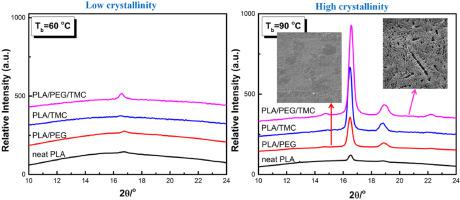Polymer ( IF 4.1 ) Pub Date : 2021-01-15 , DOI: 10.1016/j.polymer.2021.123426 Xia Gao , Shunxin Qi , Bo Yang , Yunlan Su , Jing Li , Dujin Wang

|
Polylactide (PLA) materials manufactured by fused filament fabrication (FFF) technique are usually in amorphous form and thereby exhibit poor mechanical properties and thermal resistance. Overcoming this issue requires a good knowledge of the crystallization behavior of PLA materials during the FFF process. In this work, a plasticizer (polyethylene glycol, PEG) and a nucleating agent (tetramethylene-dicarboxylic dibenzoyl-hydrazide, TMC-306), were added in PLA matrix, separately and synergistically, to tailor crystallization behavior of FFF-printed PLA parts. At a bed temperature of 60 °C, PEG played a stronger effect on crystallization behavior than the nucleating agent TMC and even the combination of TMC and PEG. This resulted in an increase of the crystallinity from 8% for both neat PLA and PLA/TMC samples to 18% for the samples containing PEG. With the increase of the bed temperature to 90 °C, TMC and PEG separately or synergistically had prominent effects on enhancing the crystallization ability of PLA during the FFF process, leading to the highly crystalline PLA parts with the crystallinities in the range of 30–40%. By means of wide angle X-ray diffraction and scanning electron microscopy measurements, shear-induced crystal structures were indentified at the filament surface as well as the weld interface. Nevertheless, the shear-induced effect had negligible influence on the final crystallinity of PLA parts. Instead, PLA parts with a high crystallinity can be attained, only when the material characteristics and the printing conditions are in favor of cold crystallization of PLA. The unique crystallization behavior of FFF-printed PLA materials offers guidelines for the fabrication of products with controlled crystallinity and hierarchical structures for specific applications.
中文翻译:

增塑剂和成核剂对熔融长丝制造过程中聚丙交酯结晶行为的协同效应
通过熔丝制造(FFF)技术制造的聚丙交酯(PLA)材料通常为非晶形式,因此表现出较差的机械性能和耐热性。要克服此问题,需要对FFF过程中PLA材料的结晶行为有充分的了解。在这项工作中,将增塑剂(聚乙二醇,PEG)和成核剂(四亚甲基-二羧酸二苯甲酰肼,TMC-306)分别和协同地添加到PLA基质中,以调整FFF印刷的PLA零件的结晶行为。在60°C的床温下,与成核剂TMC甚至TMC和PEG的组合相比,PEG对结晶行为的影响更大。这导致结晶度从纯PLA和PLA / TMC样品的8%提高到含PEG样品的18%。随着床层温度升至90°C,TMC和PEG分别或协同作用对增强FFF过程中PLA的结晶能力具有显著作用,从而导致结晶度在30–40范围内的高度结晶的PLA部分%。通过广角X射线衍射和扫描电子显微镜测量,在细丝表面以及焊接界面处确定了剪切诱导的晶体结构。然而,剪切引起的影响对PLA零件的最终结晶度的影响可以忽略不计。相反,只有当材料特性和印刷条件有利于PLA的冷结晶时,才能获得具有高结晶度的PLA零件。











































 京公网安备 11010802027423号
京公网安备 11010802027423号